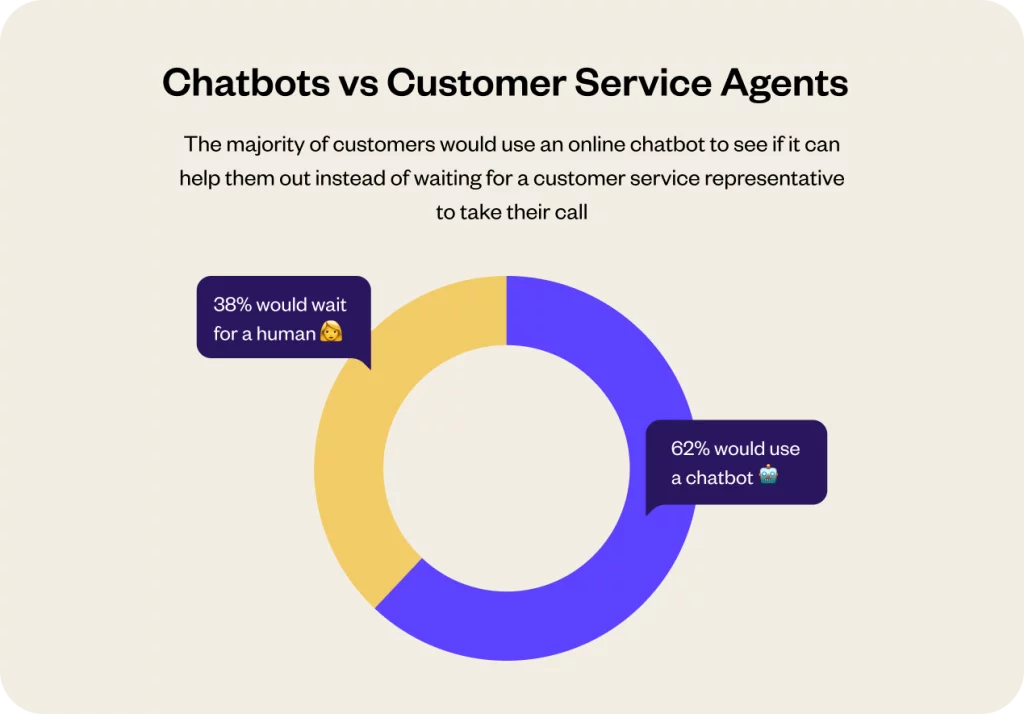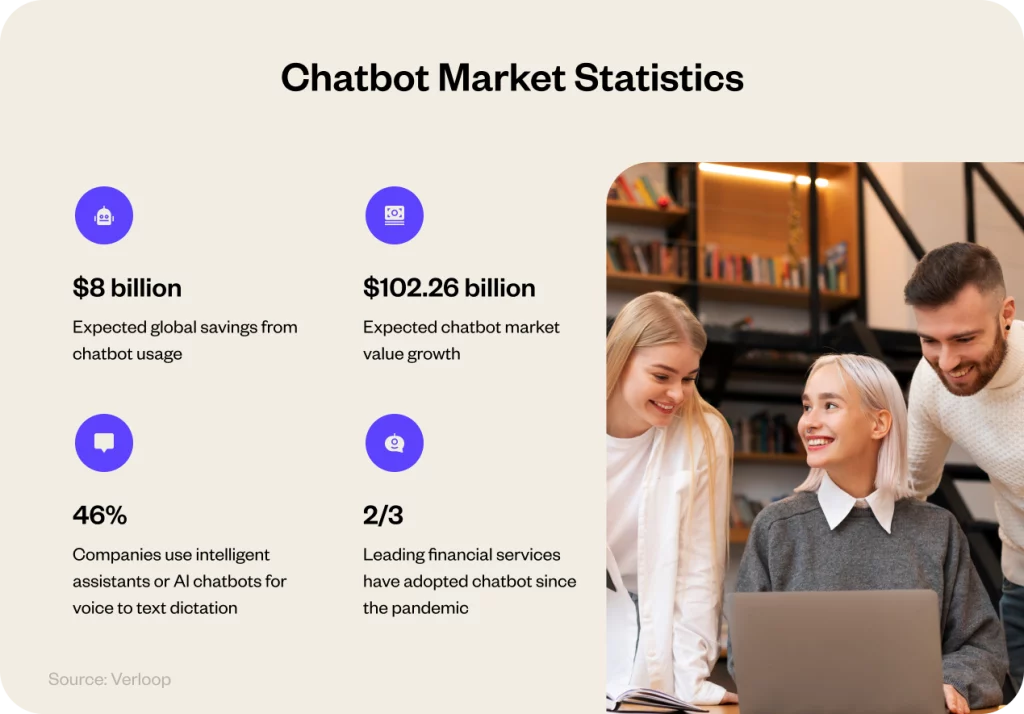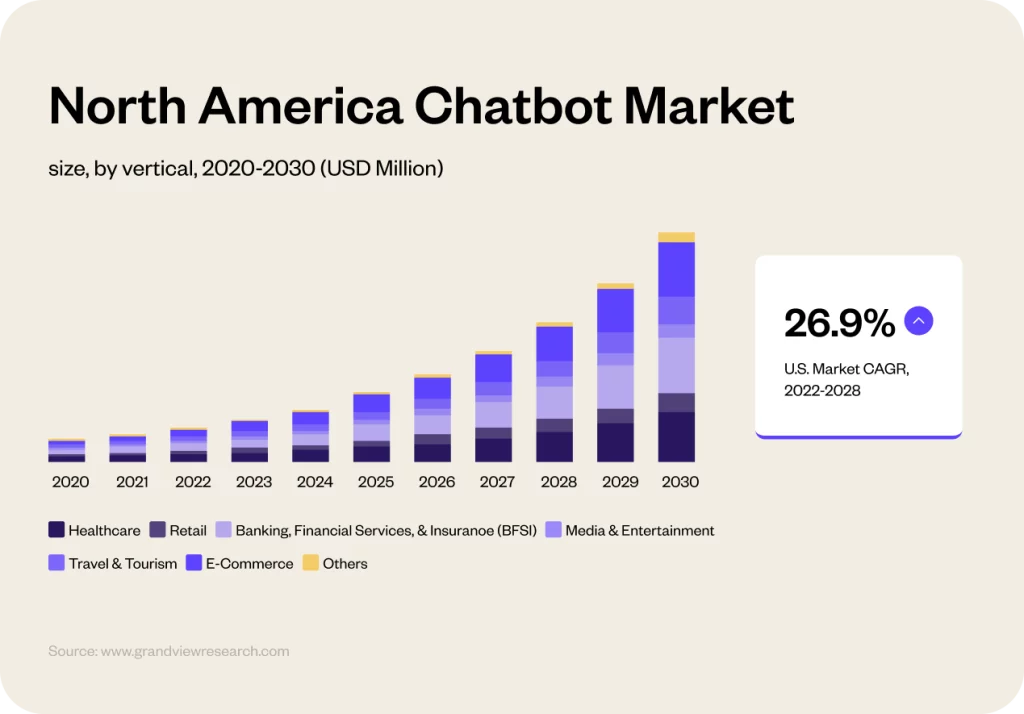Chatbot trends in 2023 have sailed beyond mere emergence; they’re making tangible waves in real-time customer interactions, creating a nexus between instantaneity and personalized communication. The conversation around the future of AI chatbots is no longer anchored in potential but has transitioned into a dialogue about refinement, optimization, and innovative applications. Engage with a narrative that delves into the contemporaneity of chatbot technology, exploring its ongoing impact and foreseeing its evolutionary trajectory in molding customer interactions, operational frameworks, and immersive experiences.
As we near the end of 2023, technology feels much more personal. Remember when chatbots were those robotic, sometimes frustrating tools you’d encounter on a website? Those days feel like a distant memory. Today, they’re more like that tech-savvy helping hand your customers can rely on—always there, always ready, and impressively insightful. And if you’re thinking this is just the beginning, you’re right.
With resounding positive feedback from 80% of web users, 2023 has been a testament to the versatile and transformative power of chatbots. From emulating human-like interactions to offering game-changing business insights, chatbots aren’t just following trends but creating them.
We’re about to explore the chatbot trends that have shaped this year and get a glimpse of where they’re headed next. Buckle up; it’s an exciting journey!
Related must-reads:
- How to create a chatbot – Best practices to follow in 2023
- 30 Chatbot applications from six key industries
- 9 Chatbot examples across industries 2023
- Enterprise Chatbot – A Guide for Enterprises [2023]
- Benefits of AI Chatbots for Businesses and Customers
Chatbots: The new standard for customer support
Nobody likes being left on hold. Whether it is Jamie trying to figure out a glitch with his online shopping cart or Emma trying to reschedule her upcoming flight, lengthy wait times can quickly sour an experience. Traditional customer service models, while essential, can sometimes falter with delays, miscommunication, or simply being too swamped to respond promptly.
According to studies, the wait is often the most grating part of a customer’s interaction. Enter chatbots: the swift, responsive, and ever-ready assistants setting a new gold standard in addressing and alleviating these pain points, ensuring every customer gets the timely help they deserve.

Key chatbot statistics
Chatbots have undoubtedly woven themselves into the fabric of modern communication. Here are some compelling figures and facts that map their incredible journey and hint at an even brighter future:

1. Mainstream adoption
In 2022, a staggering 80% of customers engaged with chatbots. More telling is that 80% of these users rated their experiences positively. What’s driving this widespread adoption? The insatiable consumer appetite for instant, 24/7 support.
2. Operational efficiency
Take a global corporation as an example. Serving a diverse clientele across various time zones can be a logistical nightmare. Chatbots are solving the challenge. They offer round-the-clock support and boast a remarkable resolution rate. Companies with companies that use chatbots and have engaged audiences could have response rates as high as 90%.
3. Global reach
Chatbots have gone global, from the corporate towers in the US to the high-tech hubs of Germany. With the U.S., India, Germany, the UK, and Brazil leading the pack, an estimated 1.5 billion people worldwide are now interacting with these digital assistants.
4. Onward and upward
A Gartner prediction suggests that by 2027, chatbots could form a quarter of businesses’ primary customer service avenues. Considering that chatbot adoption has spiked by 67% recently and giants like Oracle project that 80% of companies plan to incorporate them into their customer support, this prediction seems less a stretch and more a near-certainty.
5. Cost implications
IBM’s research reveals a golden number: chatbots can trim customer service costs by up to 30%. In sheer dollar terms, that translated to a whopping $11 billion savings for businesses in 2022 alone.
Looking at the future of chatbots, 2023 brings new trends to the landscape. According to a recent forecast from Juniper Research, about 8 billion voice assistants will be in use by 2023.
Customer expectations and the balancing act with chatbots
Customer expectations from chatbots revolve around two key aspects: receiving quick responses at any time and accurately recognizing their problems. Achieving the right balance between these two requirements is crucial for modern customer service. A combination of traditional human-operated live chat and chatbot automation often provides the best approach.
Generational trends
Younger consumers, particularly Millennials and Gen Z, exhibit a heightened digital acumen and a comfortable familiarity with chatbots. However, they are also discerning in recognizing that diverse purchase scenarios may necessitate varying communication approaches. This very discernment among younger demographics has propelled the success of chatbots.
A study shows that around 20% of Generation Z shoppers prefer to start customer service interactions with chatbots. This contrasts with just 4% of baby boomers with the same preference.
Gen Z holds brands to high standards, demanding alignment with their values, personalized incentives, and real-time engagement. Prompt responsiveness is key, even when they reach out at night. To meet these demands, chatbots are essential. Gen Zers want personalized 24/7 service, and chatbots can efficiently fulfill their expectations.
Industry-Specific Impact
Chatbots have transcended their role in customer service and are leaving a lasting impact across a spectrum of sectors. Here’s a glimpse into their pervasive influence:

1. Impact of chatbots in BFSI
The financial sector is witnessing a chatbot revolution, with the market poised to reach nearly $7 billion. These financial assistants are not just about dollars and cents; they’re about saving precious minutes for customers. Chatbots in finance expedite customer inquiries, shaving off up to 4 minutes per interaction, enhancing efficiency and customer satisfaction.
2. Impact of chatbots in healthcare
The healthcare industry, too, is embracing chatbots. Research shows the market will likely soar to $1168 million by 2032. These virtual assistants don’t just facilitate smoother administrative processes; they offer substantial cost savings. By streamlining appointment scheduling, prescription refills, and answering medical queries, healthcare chatbots enhance patient experiences while reducing overhead expenses.
3. Impact of chatbots in retail and e-commerce
Chatbots have found their place in retail, elevating customer engagement and sales. They’ve boosted sales conversions significantly by offering personalized product recommendations, helping with order tracking, and ensuring smooth shopping experiences. Many retailers have reported up to a 70% increase in conversion rates with the strategic use of chatbots.
4. Impact of chatbots in hospitality and travel
In the hospitality and travel industry, chatbots are revolutionizing the way guests and travelers experience services. Hotels and travel agencies deploy AI-driven assistants to facilitate quicker check-ins and streamlined reservations and to provide instantaneous recommendations on local attractions or dining options. Airlines utilize them for swift ticket bookings and real-time flight updates. By integrating chatbots, the hospitality and travel sector ensures a seamless and personalized journey for their patrons, from booking to stay to exploration, thereby elevating overall user satisfaction.
5. Impact of chatbots in education
Educational institutions are adopting chatbots to streamline administrative processes and enhance student experiences. These bots assist with course registrations and answer frequently asked questions. Furthermore, they provide students with essential information, ensuring a smoother academic journey. The education sector is witnessing improved efficiency and student engagement through chatbot integration.
6. Impact of chatbots in the automotive industry
In the automotive industry, chatbots are transforming customer support. They help vehicle owners with maintenance schedules, troubleshooting, and even remote diagnostics. Automotive chatbots offer instant assistance and reduce the requirement for in-person service appointments. As a result, they improve customer loyalty and practical efficiency.
7. Impact of chatbots in the energy and utilities
In the utilities sector, chatbots are revolutionizing customer service. They enable providers to manage most incoming requests across multiple channels in numerous languages. These AI-driven agents offer personalized responses and can schedule services like waste pickups and technician visits seamlessly. Additionally, they enhance revenue by streamlining payment collections across channels. With solutions like Yellow.ai, the utility industry is elevating operational efficiency and customer experience.
8. Impact of chatbots in HR and recruitment
In HR, chatbots have transformed the recruitment landscape. They’ve driven a remarkable 95% surge in leads on career websites. It enabled companies to access a broader pool of potential talent. Furthermore, chatbots have become invaluable time-savers, liberating thousands of work hours annually by automating routine HR tasks.
Chatbots and future possibilities: Boosting sales and conversions
The significance of chatbots goes beyond customer support; they can also play a significant role in sales and marketing. A Business Insider Intelligence report predicts that global retail consumer spending via chatbots will reach an impressive $142 billion by 2024. Companies introducing chatbots are generally satisfied with the results, especially in the e-commerce sector.
The future of chatbots: 2023 and beyond
The chatbot industry is witnessing impressive growth. Data projections indicate it will surpass $994 million. Therefore, this represents an annual gain of approximately $200 million. It is a phenomenal compound annual growth rate (CAGR) of about 22%.
Notably, businesses of all sizes are integrating chatbots into their operations. Moreover, smaller businesses are leading the way because they need efficient customer connections.
Now, let’s explore how the chatbot future trends will shape the future of AI chatbots:
1. Chatbots will be more human-like
Advancements in NLP and ML are propelling chatbots toward a future where their conversations closely mimic human interaction. Users will experience more natural and engaging interactions with chatbots, improving user satisfaction.
2. Deep customer insights to drive chatbot behavior
AI’s increasing sophistication will enable chatbots to analyze vast user data troves to gain insights into individual preferences and behavior. Armed with these insights, chatbots will offer highly personalized responses and recommendations.
3. Use of AI in contact centers
As technological advancement continues, chatbots will play a central role in reshaping contact centers. Their capability to manage routine inquiries with swift precision is expected to evolve to a point where they can run contact centers autonomously. While human touchpoints will remain crucial for complex and sensitive interactions, the synergy between chatbots and humans will lead to a new era where fully autonomous contact centers are a reality, promising unparalleled efficiency and a consistent customer service experience.
4. Voice bots will be mainstream
With the rising popularity of voice assistants, chatbots equipped with voice capabilities will become increasingly prevalent. This trend will empower users to interact with chatbots using voice commands, further expanding their utility.
5. Customer experience (CX) will drive chatbot adoption
Businesses will prioritize chatbots to deliver exceptional customer experiences. These AI-driven entities will facilitate seamless, personalized, round-the-clock support, boosting customer satisfaction and loyalty.
Chatbot growth drivers
1. Messaging platforms
Businesses will seamlessly integrate chatbots into popular messaging applications, making them easily accessible to users. Chatbots will readily assist and engage with users on Facebook Messenger, WhatsApp, or other messaging platforms.
2. Automated payments
In the financial industry and on transaction-led platforms, chatbots will provide users with secure and convenient options. They can use them to make payments, check balances, and carry out various financial transactions. The added functionality will streamline financial interactions and enhance user convenience.
3. Adoption of AI
Social media platforms will increasingly harness the power of chatbots to engage with users. Businesses will use social media chatbots to address inquiries promptly, offer product recommendations, and provide real-time support.
4. Internal use for enterprises
Enterprises will employ chatbots for various internal tasks, ranging from HR inquiries to IT support. By automating these processes, chatbots will enhance work efficiency within organizations, allowing employees to focus on more strategic tasks.
As 2023 winds down, one thing is clear: the era of chatbots is only just beginning, promising more innovations, transformations, and integration into our daily existence.
Yellow.ai’s DAP: Ushering the future of chatbots
Now, let’s talk about how technology like Yellow.ai’s generative AI-powered Dynamic Automation Platform (DAP) fits into this landscape. Imagine a large corporation with customer support requests pouring in through various channels: emails, text messages, and phone calls. Handling these manually is time-consuming and costly.
Yellow.ai’s DAP is the solution, enhancing customer and employee experiences using generative AI. It’s like having an army of chatbots capable of seamlessly handling conversations across text, email, and voice. It not only boosts efficiency but can cut support costs by a whopping 60%.
Summing up the future of chatbots
Chatbots have become integral to the modern business landscape, enhancing customer service and streamlining operations. Their widespread adoption, efficiency, and ability to meet customer expectations make them a valuable asset for businesses of all sizes. Chatbots will shape the future of business-customer interactions for years to come. In particular, integration of voice and AI-powered chatbots and their impact across various industries.
As businesses evolve, AI will become more deeply integrated across diverse industries. Moreover, chatbots stand ready to transform the communication and customer service landscape. Likewise, chatbots will also enhance our everyday experiences. Consequently, companies that adopt these burgeoning trends will secure a significant competitive advantage. It will empower them to deliver personalized services more efficiently to their clientele.
Frequently asked questions (FAQs)
What does the future hold for chatbots in 2030?
By 2030, they’ll be deeply woven into our professional and personal lives. They’ll probably be as common as smartphones are today! Drawing from vast data sources and employing advanced AI, they’ll proactively assist us, be it streamlining office tasks or helping manage our homes. Integration with IoT devices will mean your chatbot could suggest a recipe based on what’s in your fridge or even remind you of an impending deadline at work. Furthermore, as global industries recognize the efficiency and cost-saving potential of these bots, there will likely be a surge in their adoption across sectors, from healthcare consultations to finance advisory. Their evolution will be marked by their technical abilities and ethical considerations, ensuring user privacy and data security. So, by 2030, chatbots won’t just be tools we use; they’ll be intelligent partners we trust.
Why are chatbots the future of communication?
Chatbots are revolutionizing communication by merging constant 24/7 availability with the prowess of advanced analytics and Natural Language Processing (NLP). Their cost-effectiveness and scalability make them invaluable to businesses, while their ability to adapt, learn, and offer personalized interactions enhances user engagement. Integrated seamlessly across platforms, they streamline tasks and are evolving to embrace immersive technologies like augmented reality. With consistent outputs, adaptive learning, and multilingual capabilities, chatbots stand poised to be the linchpin in the digital communication of the future.
How could chatbots be shaping the future?
Chatbots will potentially reshape the future by simplifying tasks and enhancing customer experiences. Additionally, they will automate processes across various industries. This transformation will boost efficiency and foster innovation.
Are chatbots the future of customer service?
Undoubtedly. Chatbots are already transforming customer service. They provide instant responses, reduce wait times, and offer 24/7 support. Consequently, chatbots enhance customer satisfaction.
What is the main advantage of a chatbot?
The primary advantage of a chatbot is its ability to offer immediate responses, boosting efficiency and user satisfaction and leading to significant cost savings for businesses. Over time, these savings and enhanced customer experiences contribute to a positive return on investment (ROI) for organizations that integrate chatbots into their operations.
What are the limitations of chatbots?
While transformative in their time, traditional chatbots had notable limitations. They often operated based on predefined scripts, struggling with complex or unexpected queries, and lacked the nuance to understand context or sentiment, leading to impersonal or inaccurate responses. In contrast, advanced AI chatbots have surged, leveraging sophisticated Natural Language Processing (NLP) to grasp the context, adapt to user behavior, and offer incredibly human-like interactions.























